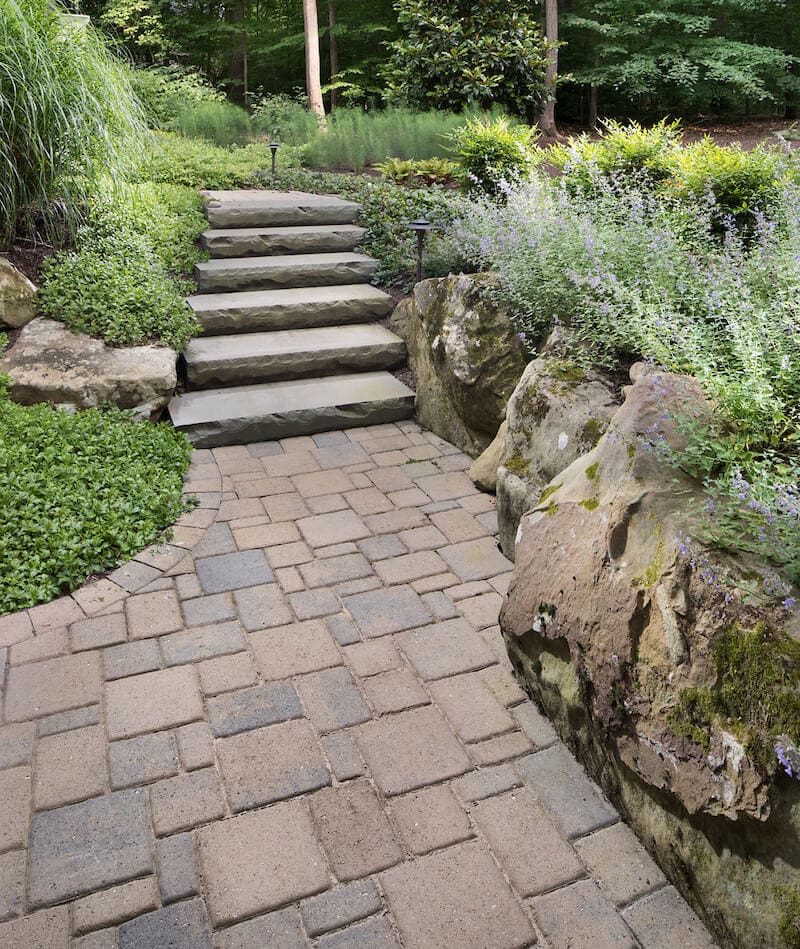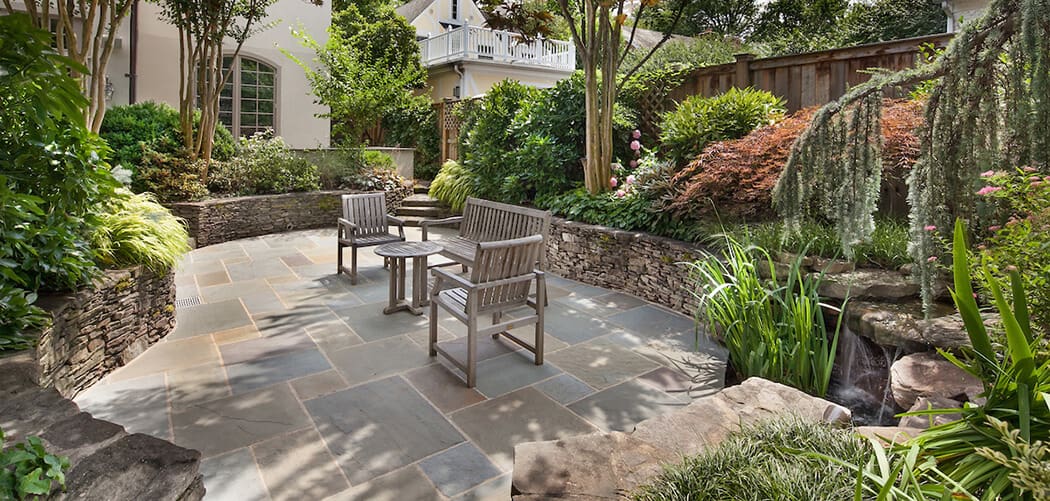
Patios and walkways are essential components of a beautiful, functional landscape. They provide both aesthetic value and a gathering place for families to enjoy the outdoors. But after regular exposure to the elements, patios and walkways will begin to deteriorate. Brick and stone surfaces may become uneven over time. They may heave up in some spots and settle in others causing tripping hazards or depressions that stay wet for hours after a rainstorm. Weeds may start to grow between cracks in stones or ants may decide to colonize and share patio time with you. These too will undermine the integrity of your patio or walkway surfaces.
These patio and walkway problems may be irritating, but they are common hardscape maintenance issues. No matter how sturdy or carefully constructed, walkways and patios are built on the earth, which shifts and moves with changes in temperature and moisture over time. Ha
rdscapes need consistent proactive maintenance just as your garden beds do. And staying on top of routine care can help prevent a costly crisis down the line.Prevention: The Best Solution to Patio & Walkway Problems
The best way to correct patio and walkway problems is to prevent them! Each spring, it is essential to perform routine maintenance on your hardscapes to prevent irreversible damage. Winter is hard on bricks and stones, so once the weather warms up, focus on the easiest and most obvious tasks: repointing, resealing, and powerwashing. Following ar
e some of the best preventive maintenance practices for patios and walkways:- Repointing Brick and Stone Surfaces
Repointing involves removing deteriorated joint material between bricks or flagstone and replacing it with fresh concrete to even out the surface. If the joint material is polymeric sand, it will need to be replaced when it is discolored by pollen, when weeds start to poke through, or when it becomes inhabited by mildew, mold, or moss. This type of sand acts as a flexible bonding agent between flagstones or pavers. It contains polymers that react to water by becoming elastic and sticky, holding stones or pavers in place while adjusting to small movements. It should be replaced entirely every two to four years. - Resealing Paver Surfaces
Putting a sealer on the surface of pavers can help the material hold its color longer. It also works like varnish on wood by drawing out natural textural contrasts and color. Sealing pavers will also help them resist the effects of harsh weather conditions and make routine maintenance faster. - Power Washing Flagstone Surfaces
Power washing to remove mildew can make a stone patio stand out beautifully, but it must be done by an expert to prevent damage to nearby plants, turf, or the patio surface itself. Power washing will make a flagstone patio look brand new if done properly – but if done incorrectly, it can permanently mark up the stone.

Power washing may also be used to remove efflorescence which is a natural chemical reaction initiated by water. Moisture held internally or on the surface of porous materials such as flagstone, brick, concrete pavers, or mortars, brings soluble salts to the surface. When that moisture evaporates, it leaves a coating of salt. It can appear immediately after a new installation or gradually over several seasons. Some people worry that efflorescence is an indicator of substandard materials or workmanship. It is not. It happens naturally when environmental conditions are right and is e
asily remedied.Plan for Normal Problems Caused by Settlement

No matter where you live, the elements play a factor in your landscape’s longevity. Over time, the effects of wind, rain, heat, cold, and subsurface water movement will cause settlement. A patio that is set in a concrete base is the most solid and immoveable surface. Flagstone or broken flagstone set on a compacted substrate base – even if done correctly – is more vulnerable to settlement over time. Periodically, you must take up the stone, refresh the base
, and relay it.Patio on Concrete Base
The big advantage of concrete is durability. When a patio or walkway is supported by a concrete slab, even if an area underneath it were to wash out, it is less likely to tip up or form a depression. That’s because the solid slab will bridge over small voids created by erosion underneath. On the downside, a concrete base is expensive and impermeable, so surface water can’t percolate through it naturally i
nto the ground.Unlock the full potential of your lawn and gardens!
What’s the difference between a conventional landscape company and one whose staff understands design, horticulture, and landscape systems? To find out, click the button below.
Patio on a Compacted Substrate Base
With a compacted substrate base, the effect of underground water movement is more likely to show up as heaving or depressions. Over time, water movement may pull smaller particles away bit by bit, causing stone or pavers to sink or tip. If you have a pocket underneath a stone where water builds up and freezes, it’s going to cause that patio or walkway to heave or fracture and dislodge st
ones or pa vers.Deal with Drainage on Your Property
Ongoing settlement issues with your patios and walkways co
uld be due to poor drainage or the absence of a proper drainage system when the hardscape was installed. It is worth your while to get professional advice and if recommended, invest in a drainage plan that will prevent this problem from recurring year after year.Here’s why: Both patio and walkway features are affected by the freeze/thaw cycle. Deterioration in a hardscape happens the same way as a pothole on a road – when left alone, the hole just gets bigger because every time it fills with water and freezes it grows. This small maintenance task can grow into a big problem if l
eft unattended.Fix Little Problems to Prevent Big Ones

[elementor-templat
e id=“12476“]Another reason not to put off routine seasonal maintenance: With a brick or stone walkway it can be difficult to match the material since many years may have passed since it was installed – and it may be difficult to get an exact match even with the same product because the older material is weathered. It is better to regularly make small repairs that will
be unobtrusive.If you notice the stones in your patio or walkway have been tipping up at the edges, cracking, or settling, it may mean you need to commit to a seasonal mainte
nance schedule.All images ©Morgan Howarth Photography excepted as noted.